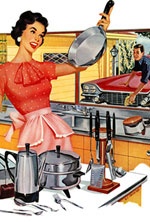Barack Obama was deemed the "biggest celebrity in the world" on the 2008 campaign trail and realistically, he had the ratings, the celebrity backing, and the loyal fans to qualify him of that status. Nielson ratings released that 38.4 million viewers watched Barack Obama's acceptance speech at the Democratic National Convention. In fact, Obama captured more viewers than the opening ceremony of the 2008 Olympic Games in Beijing and the final show of "American Idol."
Even after the President took office in January, Oprah still backed the Obama family. Her April issue of "O" magazine marks the first time Oprah has shared the cover in the nine years of it's existence, with none other than Michelle Obama.
It's no wonder she's the only person to appear on this list every year since it began...It's said that the average human has 100,000 heartbeats a day. Oprah may not have more of them than the rest of us, but each one is powered by purpose (p.120).There is no denying the power Oprah Winfrey holds in American society. A book is sold out immediately if it makes her book club and a product she chooses to promote becomes the next big hit; bluntly many women across the country follow Oprah faithfully. So when she decides to not only support but to actively campaign for President Barack Obama, she obviously will have an effect.
However, Oprah's campaign did not come without some raised eyebrows. The following is the clip where Oprah defends her pledged support of the Illinois senator on Larry King,
The clip seems simple but in fact, many of her lines were critiqued by opponents. When she said that she believes a black man can be in office and that Barack Obama is the man that will do that, it was labeled racist remark as well as a bash to Hillary Clinton. It is an example of how a small comment can quickly became something big. From that point forward, many American's assumed that race was the reasoning behind Oprah's support
The next clip is a prediction by MSNBC about what the Obama campaign announces that she will actively campaign in Iowa and New Hampshire for Barack Obama.
The clip points many things that eventually became an issue in the campaign. The reporters recognized the influential effect Oprah could have. The said the things everyone was thinking, and even predicted a possible hit on Oprah's ratings, which did happen in early 2008.
The Los Angeles Times did an article on the effect of Oprah's endorsement on her own personal ratings. The author of the LAT blog, Andrew Malcom, first explains,
Oprah's political travels produced a media feeding frenzy and a publicity bonanza with women routinely fainting in the front row. The campaign said her rallies produced 10,000 new volunteers.But he also points out what it did to Oprah,
By August last year, a CBS poll found her favorable rating had plunged from 74% to 61%, still twice as good as the president but nearly a 20% drop. But 10 days after the campaign media explosion her favorable rating had dropped further to 55% and her unfavorable ratings for the first time climbed to 1 in 3.Many women were angry at her for supporting a male over Hillary Clinton, as she is an active feminist. Others were angry that she turned Barack Obama into a mega-star and others still thought she was an wrongly swaying Americans votes.
The New York Times article titled THE MONEY ISSUE; The Celebrity Solution raises awareness of the celebrity activist trend. The article makes a few profound statements,
Stars -- movie stars, rock stars, sports stars -- exercise a ludicrous influence over the public consciousness. Many are happy to exploit that power; others are wrecked by it. In recent years, stars have learned that their intense presentness in people's daily lives and their access to the uppermost realms of politics, business and the media offer them a peculiar kind of moral position, should they care to use it.....But a weapon that powerful is bound to do collateral damage (Traub, 2008, p. 1).Traub's statements find truth in the 2008 election cycle. Oprah Winfrey was just one of the many stars that adamantly backed their political candidates in the media. They used their celebrity status to attract crowds and bring attention to the issues at hand. Yet, Traub was insightful in his last line of the quote, "A weapon that powerful is bound to do collarteral damage." Oprah did just that, she hurt herself and some claim that she hurt the credibility of the Obama campaign. Some analysts point fingers at Oprah for creating Obama's celebrity status which often was a weakness zereoed in on by the Republicans especially in John McCain's celebrity ad.
Nonetheless, Oprah was a major factor. Obama acknoledged the support Oprah gave was a major boost in early campaigns. While polls showed that she didn't have much of an effect on direct votes, she did get alot of new faces in. Oprah acknoledged her power, saying in interview with Larry King,
Well the truth of the matter is, whether I contribute or not contribute, you are limited to how much you contribute, so my money isn’t going to make any difference to him. I think that my value to him, my support of him, is probably worth more than any check.Yes, Oprah felt that backlash of her support, but on the flipside many people will argue that her support got President Obama into the White House. We will probably never know, but her celebrity activism will be a good example for future causes.













